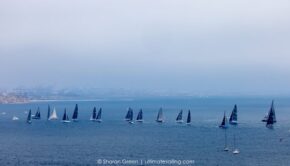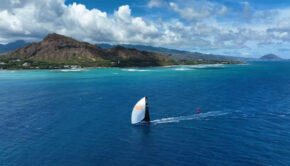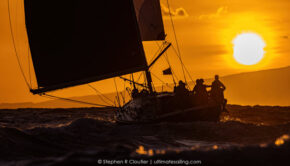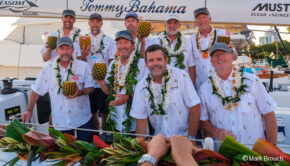In Pursuit of the Transpac Record
Published on May 1st, 2017
Countdown to the 49th biennial Transpac is well underway, with a quality fleet preparing for this summer’s classic 2225 nm race from LA to Honolulu.
In all, 63 monohull and multihull entries from 7 countries are now entered, ranging in size from Chris Lemke and Brad Lawson’s Hobie 33 Dark Star to two 100-footers: Comanche, skippered by Ken Read, and Manouch Moshayedi’s Rio100. Once class divisions are decided, there will be three separate starts on July 3, 5 and 6.
The final start will attract the fastest boats, which in 2015 was also two 100-footers: Roy Pat Disney’s and Bob Oatley’s Wild Oats XI and Moshayedi’s Rio 100.
While no records were set, they both got their names inscribed on hardware, with WOIX notching the lowest elapsed time (6:10:37:02) on the course to win the Merlin Trophy, and R100 nabbing the Barn Door Trophy for the first monohull to finish without powered assistance (7:05:34:07).
Jim Clark’s Comanche, which holds the current monohull 24 hour speed record of 618.01 miles, wants the Transpac record, which means getting to Honolulu in less than 5 days 14 hours 36 minutes 20 seconds, the mark set in 2009 by Neville Crichton’s Reichel/Pugh 90-foot Alpha Romeo II. To achieve this level of success its no surprise both boats had on board one of the most successful ocean racing navigators in the history of the sport: Stan Honey.
Stan’s success as a navigator in transpacific races (Transpac, Pacific Cup, Victoria-Maui) is unparalleled: in 22 races he and his teams have won line or class honors 10 times – an impressive record in itself. And he may have made that 11 had he not sustained a head injury while on board Comanche shortly before he was due to compete on Wild Oats XI in the 2015 Transpac, and was ably replaced by Nick White who guided Wild Oats XI to line honors – but no record due to the light weather in that year’s race.
“I think this record time is achievable without having to have unusually windy conditions, but just stable breeze along the course,” Honey said. “The year we did this on Alfa the breeze was not particularly strong, it was just relatively steady throughout the trip.”
This is not just a hunch. Not only is Comanche capable of stunning speed – her 24 hour record dwarfs Alfa’s record on the Transpac course of 480 miles – but using weather data and routing software, Stan came to this conclusion after an exhaustive analysis of digitally sailing this race over the past 13 years.
“I’ve routed Comanche on the race course using historical GFS weather data for 143 starts. I ran routes starting every day 1 July through 11 July, from 2004 through 2016. Statistically we’ve got a reasonable shot at it starting on any given day, but obviously there could be rotten enough weather to make it pointless to start on the 6th.”
Thus, there is a scenario where Comanche might do what the 104-foot trimaran Lending Club II did in the last race: sail the course on a different start day in order to optimize their chances of achieving a course record, thereby giving up the opportunity to win any race trophies.
“Given that Comanche is out of the hunt on handicap or for the Barn Door, if we had terrible weather for a start on July 6th it would be fruitless to just sail the course for no reason,” he said. “If the weather forecast was much better for a nearby day, giving us a good shot at the passage record, I suspect that Ken and Jim would go for that.”
Comanche’s unusually wide hull form is different than both Oats and Alfa, since she is designed to be more stable to carry more sail area in a wider variety of windy conditions. Comanche also has an unusual multiple option sail plan that can carry a large and diverse array of headsails and even spinnakers on furling systems on the foredeck. The position of the mast very far aft in the boat allows for this powerful feature.
Her wide hull form, however, also makes her trim sensitive to weight and can be a limiting factor in her performance should the air go light. “We will be on a strict weight budget for this race, and have to make important sail and crew selection decisions in order to optimize performance for weight.”
One sail in the inventory that is particularly effective when in its range of reaching angles is her A3 sail, which is too narrow to be recognized as a spinnaker but also too wide to be a rated as a headsail in the ORR rating rule system used in Transpac.
Comanche petitioned TPYC to allow them to use this sail nonetheless, and permission was granted with the application of a significant rating penalty. Not interested in corrected time honors, this was acceptable to the Comanche team since their only interest is in going as fast as possible to the finish at Diamond Head, regardless of rating.
TPYC Technical Committee Chairman Alan Andrews said “These ‘large width headsails’ are common in oceanic racing designs, but not used in general fleets like we have in Transpac. TPYC wants to keep a level playing field within the rest of the fleet and not ignite an expensive sail development war shortly before the race. However, we have been historically supportive of innovation and speed, so Transpac would rather allow the fleet to use these sails with the addition of a significant additional rating assessment than not allow them.”
This was good news for Commanche. “That A3 has proven to be an extremely versatile and fast sail for us,” says Honey, so its likely it will make the cut when deciding what to have on board when they start off Point Fermin on July 6th.
Stan also said the array of foils and boards on Comanche will also get evaluated carefully to find trade-offs in their weight and addition to performance through the course of a “typical” Transpac, which includes a small amount of beating, a little more reaching, and a lot of running. The decisions the team makes on this and the sail selections will very much depend on Stan’s expertise in weather forecasting and route modeling to simulate what the team will encounter on the race.
Armed with the right sails and foils, a world-class crew, Stan’s experience, and the right weather, Comanche will have a very real shot at posting a new time on the beautiful Transpac Honolulu Race Elapsed Time Record Trophy (aka, the “Clock Trophy”) donated by one of its winners and long term patron of the race, Roy E. Disney.
“Winning Transpac is not an easy achievement by any measure, and setting records is even more difficult,” says TPYC Race Chairman Bo Wheeler. “This is what makes this race have such enduring appeal for offshore sailors from around the world, and we’re pleased to have a superb team like Comanche come give this a try. We wish them and all our entries good luck in their preparations during these final few months remaining to the start.”
Event details – Entry list – Facebook
Source: TPYC









 We’ll keep your information safe.
We’ll keep your information safe.